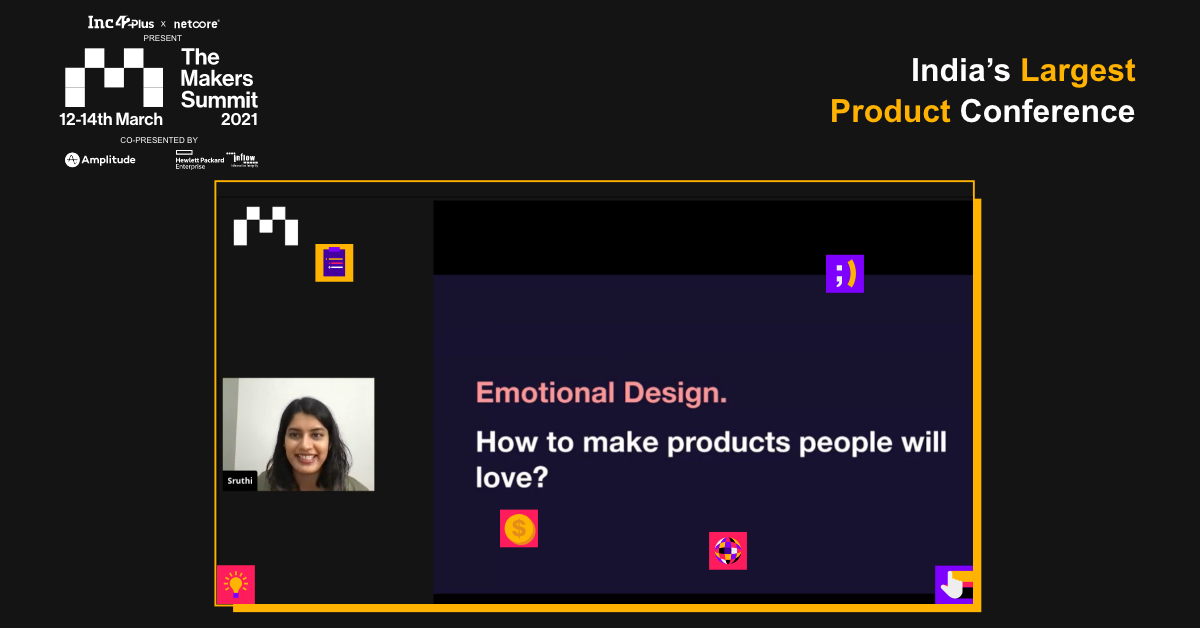Taking a masterclass on emotional design at The Makers Summit 2021, Sruthi Sivakumar, design head at Bounce implored stressed the importance to make products that create an impact with users
Quoting famed author Donald Norman, Sivakumar explained the three emotional levels a designer can leverage to connect with users better
She highlighted the importance of ‘empathy map’ in order to gain deeper insights into user behavior.
“Design is really an act of communication, which means having a deep understanding of the person with whom the designer is communicating.”–Donald A. Norman, author, researcher, and director of Design Lab at University of California
Product design is not only about creating a UX/UI which follows one of the many current trends such as minimalism, modularity, or the return of retro shades. The ultimate goal of any design is communication and to generate a positive reaction as a result of that communication. And that was the topic Sruthi Sivakumar, head of design at the shared mobility startup Bounce, took up at The Makers Summit 2021. In her carefully crafted masterclass, she delved deep into how to build products that can form a lasting connection with the users.
Sivakumar opened her session with a poll on two different UI instances of the language learning app Duolingo. The first one had a minimal design with text popping at the bottom to indicate a correct response and completion of the exercise. The second instance had animated figures celebrating and clapping when the user got the answer correct. The audience was asked to pick which UI they liked more.
The result of the poll saw 80% of the audience pick the second option. Sivakumar explained that there are no right or wrong choices as it all depends on the target demographic the app was targeting, yet there was one important learning from this polling exercise.
“What we are trying to understand today is why did we choose the second option? What worked here? And what are things we can do to build such products that are an instant hit?” said Sivakumar.
What Is Emotional Design?
Every decision that we take in our lives is impacted by some emotional input. Emotions dictate our choices and preferences, and hence it is important to generate a positive emotional response when designing a product. Positive experiences always arouse curiosity, liking, and loyalty. Negative emotions safeguard us from repeating the same experiences and make us wary of them.
Moving away from the current product world, which is becoming more mechanical, Sivakumar highlights the need to focus on making the users feel a certain way when using a product to ensure their attachment towards it.
The product design sphere itself has evolved to move from user interface to user experience. The objective of design has changed from making the user go from one screen to another and minimizing the clicks to focus on the experience of the user in the journey of the app.
Quoting Norman, Sivakumar explained the three levels of emotions. The first is visceral emotion which is the first impression of any product. Behavioral emotions are generated through the experience, which is dictated by the usability of any product. The final level is reflective emotions, where through conscious reviewing, the long-term impact of a product is assessed as delightful or unappealing.
Understanding The Three Levels Of Emotions
Visceral emotions can be summed up as ‘Love at first sight.’ The emotion works in a visual or sensory plane and the impact is set by the first moment when a user begins to use a product. That first impression sets the tone for any further interactions a user may have with the product.
Behavioral emotions, as Sivakumar explained, are straightforward. The emotion is dependent on patterns of familiarity and ease of understanding these patterns to navigate through a product. When an interaction with the platform behaves the way it is supposed to do, a joy in the form of satisfaction is derived. In product terms, the key is to optimise the usability and to align it with user-friendliness.
Reflective emotions are based on rationality. The emotion comes into play after a user has used the product several times and reflects upon his experiences. A positively impactful emotion encourages users to share their experiences with others. Further, this also creates a sense of identity with the product which leads to improved long-term retention.
However, the discussion about emotions is incomplete without understanding the keyphrase that ‘form follows function’. Sivakumar stressed that to capitalise on these emotional patterns, the product first must add value to the user. It must be functional, reliable, and usable. Without those core elements, no design can make a product great.
How To Design For Emotions?
Understanding the framework to design for emotions requires research and relying on user feedback. Citing examples of Slack, Sivakumar pointed at how the platform is targeted towards young professionals and as a result, it focusses on being feature-rich, uses emojis and the platform’s color palette is vibrant. On the other hand, Skype is targeted towards the corporate and its focus is on keeping a minimal design and puts the functionality on top.
Sivakumar suggested talking to the users to understand their persona and know what they like. The age group, tech-savviness, urban or rural-centered, all of the metrics determine the direction of design to maximise the positive reinforcement.
After understanding the persona of the user base, the next step is to know the users better using an empathy map. An empathy map helps gain deeper insights into the users. The map records user experiences based on what they hear about the product from peers; what they see when they use the product; what they say about the product after using them; and what they feel about the product. This system helps the product team be in the shoes of their users when making a user-oriented decision about the product.
Another often overlooked part of designing a product is the user journey. The user journey takes in consideration of various in-platform experiences such as activity, goals, touchpoints and emotions. These help determine where a user is experiencing difficulty in using the product and how to place an intervention to improve upon it.
For example, asking a user to fill out a survey while he is waiting for a cab may not be met with a positive emotion as the user would be anxious for the cab to arrive. User journey solves this problem by helping the designer identity the right moment to place a survey so the user is relaxed while answering it.
The Frameworks For Emotional Design
Sivakumar, in the final part of her session, highlights the different frameworks used in design to achieve emotional responses.
Personality and contrast: People like interacting with humans more than machines. So, it is important to give the product a personality based on the usecase of the product. Once established, color palettes, adding animations, using specific languages can all be used to align the product with the specific personality.
Use of images, videos and mascot: People don’t like to read a lot. Images are something people resonate with much quicker so the usages of visual cues always adds a layer of emotional connect with the users.
Rewards and surprises: A very easy to use method to invoke positive association with a product, it can be in any form. Getting a like on a social media platform is also a reward. The core idea behind setting these is to have something which makes the user want to come back to the platform as often as possible.
Humour, content & storytelling: Humour helps put the user at ease and makes the experience better. Content establishes clear communication and improves the usability of the product. Storytelling brings both of the aspects together and creates a cohesive environment which adds to the positive user journey.
Personalisation: Personalisation gives the user a sense of ownership of the product and helps the user form an identity with the product. Something as small as greeting the user with their own name can add to a layer of personalisation and help the user connect more with the product.
Microinteractions: It livens up the interaction of the user and makes the product more engaging. Small animations, nudges that direct a user to a specific feature or a celebratory animation on completion of a task all add to the overall experience of the user.
Closing her session, Sivakumar left the young product designers with an optimistic message, “Emotional design is very underutilised right now. As a product community, we focus on churning out products without noticing the impact it creates. Decoding how to create influence through your product is one of the most powerful growth hacks.”












